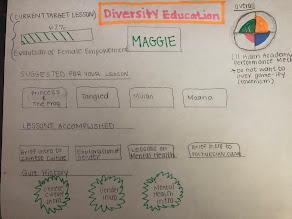Experience With Design Mode
Our groups' experience with the design thinking define mode was an exciting time, laying down the foundation for subsequent processes. Our team has grown to move swiftly and has become very adept at working off and elaborating upon each others' ideas. Additionally, Camille did a stellar job in being our process lead; she brought great organization and communication, and this approach was incredibly productive for our team. In this blog, I will explore our experience first with our work with the Persona and then our work with the How Might We Statements.
Personas
In class, Camille had asked a question that resonated with me. She had asked whether it had to be an individual or whether it could be a different interpretation of a customer, a family. Doing Disney+. The range in which who consumes this is often not just the decision-maker. I was led to consider how to encapsulate both an individual and a family. I really appreciated Camille's willingness to ask this question because it prompted me to consider a different approach than just someone who uses Disney+ for themselves.
I really appreciated the approach of brainstorming independently. Everyone created their own persona, allowing them to develop insightful nuances to their idealized customer. After finishing our brainstorming, we realized that we overlapped majorly, but those independent nuances allowed us to create an in-depth, nuanced persona. To illustrate, Camille and I both selected a millennial-age mother. She grew up appreciating the Disney brand and feels confident that her children will share this appreciation. Our ideas, albeit similar, had distinct differences that challenged or elaborated upon one another. Our other group members certainly added nuances and meaningful challenges as well.
(A Draft Of Maggie, The Millenial Mom)
I think what stuck out to me about Camille's is on the surface, hers and mine seemed incredibly similar, but once you discussed them, they directly contrasted specific ideas. For example, as listed above, Maggie works in IT as a startup manager. This emerged from our differences in whether we thought that Maggie was an early adopter or lagged behind in their consumption patterns. After having a thoughtful discussion, we reached the point where we wanted Maggie to be an early adopter. We utilized this decision to inform others, as demonstrated through her high-ranking job in the IT industry. I think this speaks to the power of brainstorming independently because had we group thought, I imagine we would have validated the cumulative Millenial mom approach, forgoing these differences that prompted such meaningful conversation.
Collectively, I think that creating our persona was incredibly useful. We created a framework to test our brainstorming. How would Maggie the Millenial Mom benefit the most from an innovated Disney+? It provides our group with a foundational grounding to build off rather than some elusive framework such as "How do we innovate Disney+?" I am a considerable organizer; I think developing a persona strikes the perfect balance for approaching innovation in an organized way but does not stifle creativity.
How Might We Statements
Our "How Might We" statements are incredible "seeds" for our ideation, as Professor Luch's lecture video elucidated. It was a great process to narrow what foundation we want to use when guiding our innovation.
Like my idea above, brainstorming independently and then coming together is an incredibly productive group work approach. Specifically, I saw it serve us exceptionally well in determining which LP criterion we wanted to select. We independently input which two-LP criteria we wanted to explore. Then, we came together to discuss which we had chosen. Quickly, it became apparent that Culture-Diversity was iterated across nearly everyone's selection. However, it is essential to note that we did not just let democracy rule without conversation. We made sure to discuss why each idea offered a practical approach. But, by the end, we identified that there was the most opportunity to innovate in this criterion, which performed as one of our LP analysis's poorest criteria.
This sentiment carried over in our how might we statement as well. We brainstormed independently and then came together to discuss. Given the mass of how many we created, we thought maybe a good way was to organize was to identify overlaps within the statements. We grouped them into themes, like the desire to promote diversity education in the platform. We then discussed which sentiments we liked of each statement for that theme; we utilized those to create a culminating how might we statement for that theme. By the end, we had three culminating themed how might we statements. We used those to identify which of these were the most compelling to pursue. We selected two of these refined statements that we believed would give us the most significant innovation opportunity.
The balance between too specific and too vague was a tricky line to tow initially. When we created those three themed "how might we statements," we made the statements too precisely. We identified that if we went forward with our initial wordings, we would feel incredibly constrained in what avenues of innovation we could pursue. Finley had the excellent suggestion of rewording it so that it was still meaningfully narrowing but not constraining. This tension was discussed in the lecture video, but it is difficult not to allow ideation to permeate too early in creating these statements in real-time.
Overall, I am very excited about the route that we as a team have narrowed in on. I am also incredibly excited at how productive our teamwork was within this process; I think we did an excellent job working together. Everyone's voices were heard and honestly considered. I am very hopeful this same positive energy will carry into our ideate phase!




Comments
Post a Comment